the place where Paleontology and Paleoanthropology meets Philately
Soviet Union / USSR
Prehistoric animals and plants, fossils, paleontologists, Charles Darwin on stamps, post stationeries and postmarks of the Soviet Union
| << previous country | back to index | next country >> |
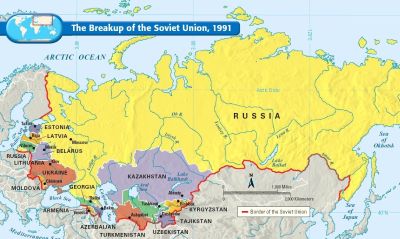 the image is
from Mapcollection
website
|
Contents:
- Country overview
- Philately of Soviet Union
- Official stamps of Soviet Union related to Paleontology
- Other stamps of Soviet Union to consider
- Postal stationery of Soviet Union related to Paleontology
- Other postal stationery of Soviet Union to consider
- Commemorative postmarks of Soviet Union related to Paleontology
- References
- Acknowledgements
The Soviet Union, officially the Union of Soviet Socialist Republics (USSR) was a socialist state in Eurasia that existed from 1922 to 1991.
It was nominally a supranational union of national republics, but its government and economy were highly centralized in a state that was unitary in most respects.
The Russian republic (which was itself federative) was not privileged by law, but the Russian nation was in some respects culturally dominant. The Union's capital was Moscow.
Beside Russia, another 14 states formed the Soviet Union.
After its collapse in 1991 all 14 became independent countries: Armenia, Azerbaijan, Belarus, Estonia, Georgia, Kazakhstan, Kyrgyzstan, Latvia, Lithuania, Moldova, Tajikistan, Turkmenistan, Ukraine, Russia.
The Soviet Union had its roots in the October Revolution of 1917, when the Bolsheviks, led by Vladimir Lenin, overthrew the Russian Provisional Government that had replaced Tsar Nicholas II.
This established the Russian Socialist Federative Soviet Republic (Russian SFSR) and started the Russian Civil War between the revolutionary "Reds" and the counter-revolutionary "Whites."
The Red Army entered several territories of the former Russian Empire and helped local communists take power through workers' councils called "soviets", which nominally acted on behalf of workers and peasants.
Before its dissolution in 1991, the USSR had maintained its status as a world superpower alongside the United States, for four decades after World War II. Sometimes also called "the Soviet Empire", it exercised its hegemony in Eastern Europe and worldwide with military and economic strength, proxy conflicts and influence in developing countries and funding of scientific research, especially in space technology and weaponry. [R1]
The first stamps of the Russian Soviet Federative Socialist Republic appeared in 1918, as two values depicting a sword cutting a chain.
While great quantities of these stamps survive, they saw little use, and used copies are worth more than mint.
In the years of the Civil War, postage stamps served as a kind of currency in a number of regions.
The next stamps appeared in 1921, after inflation had taken hold. The set's values range from 1 to 1,000 rubles.
By the next year these stamps were being surcharged in various ways, with face values of up to 100,000 rubles.
Postage stamps of the USSR were issued in the period 1923 to 1991. They bore the specific Russian inscription: "Почта СССР" ("Post of the USSR").
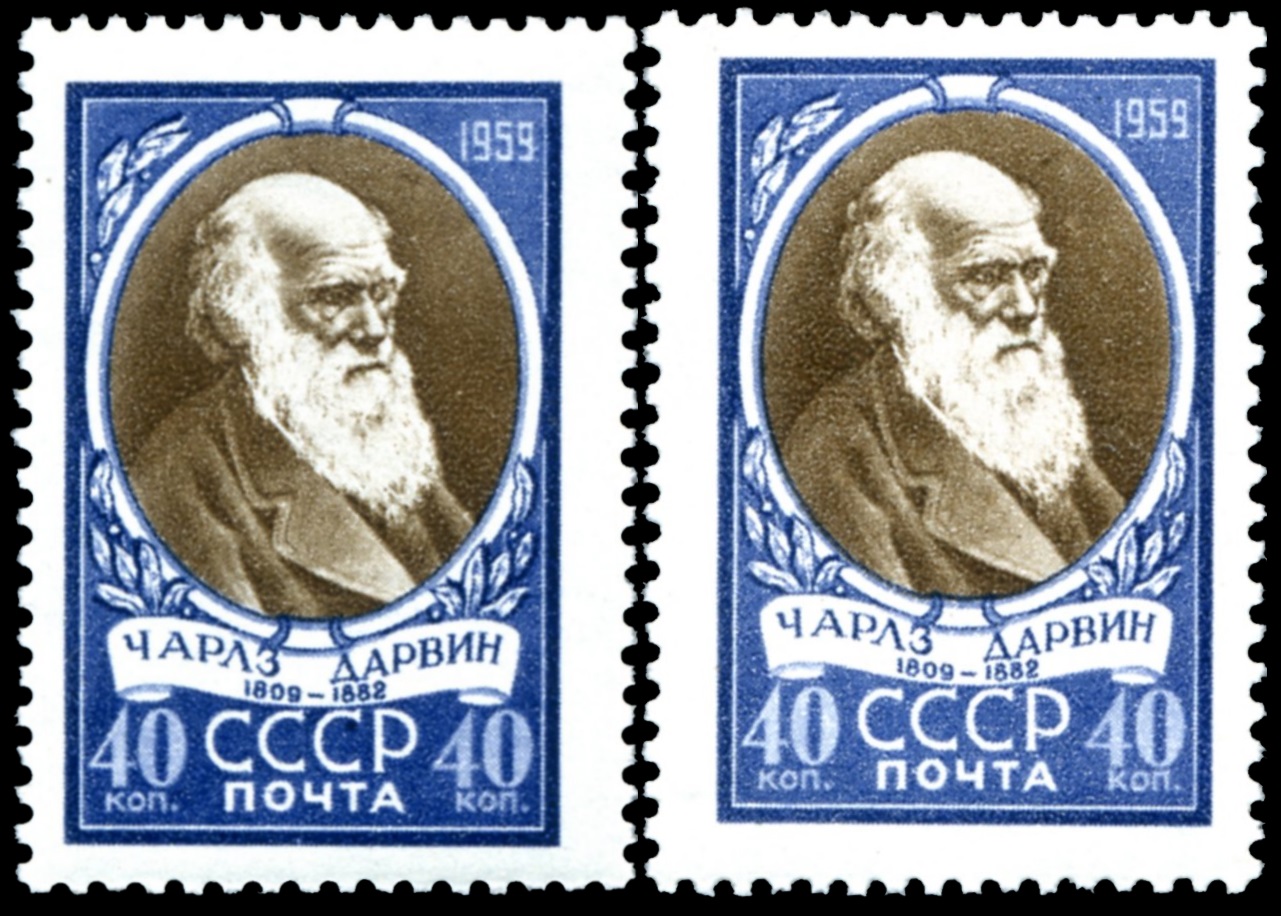
|
| Image shift on Darwin stamp of USSR 1959 MiNr.: 2195, Scott: 2166 |
Many stamps issued prior to the 1960s exhibit an image shift relative to the perforated edges of the stamps (see an example on the right).
Some of the stamps even exhibited size variations in the printed image – therefore some catalogs provide pictures of examples of issues with different image size.
In the middle 1950s, foreign philatelists start to show an interest in the Soviet stamps.
In order to fulfil this demand, some of the most beautiful stamps from the 1940s and early 1950s were reprinted by the Soviet Post starting in 1955.
Some sets were reprinted more than once - "Eminent Russian Scientists" from 1951 for example. In many cases, the reprinted stamps were printed on different paper with different raster, as paper used for original stamps had run out of stock.
Due to this opportunity, some small changes were made to improve their quality - slightly different text, better print quality of perforation and color.
These reprinted stamps sold abroad and were unavailable in the USSR until its collapse in 1990s. Technical details and quantity of the reprint issues were never provided by the Post. [R2]
Official stamps of Soviet Union related to Paleontology: fossils, dinosaurs and other prehistoric animals, paleontologists, Charles Darwin
| 17.11.1947 "100th anniversary of A.P. Karpinski" [1] | 15.08.1951 "Eminent Russian Scientists" [2] | 03.03.1952 "Greatest Russian scientist biologist-paleontologist: V.O. Kovalevsky" [3] |
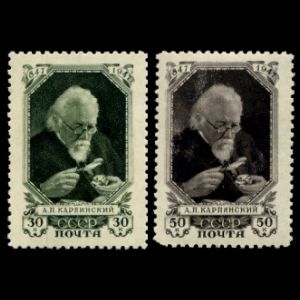 |
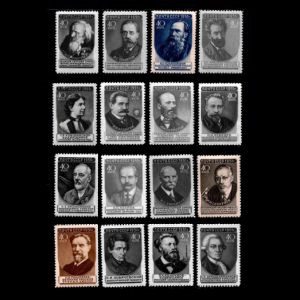 |
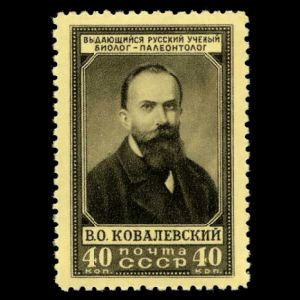 |
| 26.11.1958 "100 years since death of Karl Rouillier" [4] | 05.02.1959 "150th anniversary of Charles Darwin" [6] | 20.06.1975 "XII International Botanical Congress" [5] |
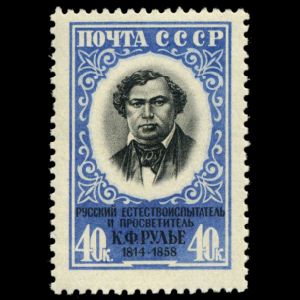 |
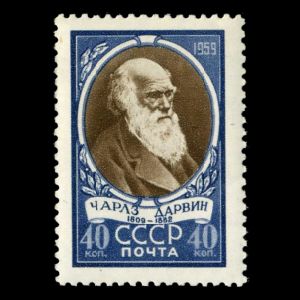 |
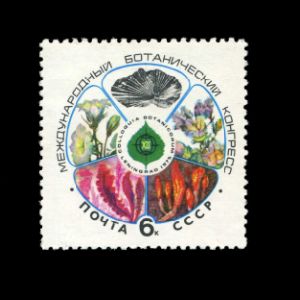 |
| 15.08.1990 "Prehistoric animals" | ||
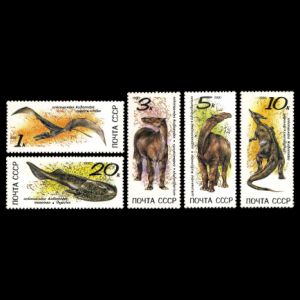 |
|
|
Notes:
[1] Aleksandr Petrovich Karpinsky (1847-1936) was a prominent Russian and Soviet geologist and mineralogist, most known as First elected president of Russian Science Academic.
However, he was also great geologist and paleontologist, who made some important discoveries from the Ural Mountains region of Russia. [R4]
In 1899, for example, he described the new bizarre species of prehistoric fish Helicoprion based on a jaw fossil found in limestones of the Ural Mountains.
In 1997, Russian Post issued a postal stationery and commemorative postmark "150th anniversary of A. P. Karpinsky" with a jaw of Helicoprion on the cachet.
Helicoprion is a genus of extinct, shark-like eugeneodontid holocephalid fish, who had
spirally arranged clusters of the individuals' teeth, called "tooth whorls"— the cartilaginous skull,
spine, and other structural elements have not been preserved in the fossil record,
leaving scientists to make educated guesses as to its anatomy and behaviour.
Helicoprion lived in the oceans of the early Permian 290 million years ago,
with species known from North America, Eastern Europe, Asia, and Australia.
[R3]
[2] The stamps set "Eminent Russian Scientists" from 1951 was reprinted twice, by the Soviet Post.
- Original set of 16 stamps was issues in 1951.
All stamps have the image size of 22.50x33mm, printed on chalk surface paper with square rasters. -
First reprint - 1955.
12 stamps from the set have smaller images size - 21.50x32mm and printed on perfect quality paper.
4 stamps, including stamp of Timiryazev were printed at the original size, but on higher quality paper. -
The second reprint - 1956.
Only 9 stamps from the set were reprinted on perfect quality paper with horizontal diamonds raster.
This issue include none of the stamps mentioned below.
Scott just mentions that these stamps exist in different sizes, without any details and price.
Michel mentions partially perforated stamps (imperforated on one of the sides) in addition to the basic set only. Reprinted stamps are not included.
Several Scientists depicted on these stamps made contributions to Paleontological research
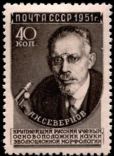 |
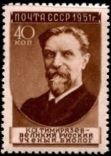 |
| A. N. Severtsov, USSR 1951, MiNr.: 1587, Scott: 1579. | K. A. Timiryazev, USSR 1951, MiNr.: 1576, Scott: 1581. |
-
Aleksei Nikolaevich Severtsov
(1866-1936) shown on the gray stamp, was Russian zoologist and paleontologist,
the founder of the study of the evolution of animal morphology.
Severtsov won worldwide recognition with major works dealing with metamerism of the head (1891–1901), the origin of the paired extremities of vertebrates (1900, 1908, 1926), and the evolution of lower vertebrates (1916–27).
In his work on phylogenetics, Severtsov sought to correlate the results of studies in comparative anatomy and embryology with paleontological findings, stressing the need for studying the structure, development, and functional significance of all systems. [R5] - Kliment Arkadievich Timiryazev (1843–1920), shown on the brown stamp, was a Russian botanist and physiologist and a major proponent of the Evolution Theory of Charles Darwin in Russia. [R6]
Two other stamps from the set show the brother and wife of Vladimir Onufreivich Kovalevsky, who was a Russian biologist and paleontologist. Vladimir Onufreivich Kovalevsky was honored the next year (1952) with a stamp issue of his own.
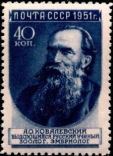 |
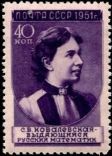 |
| A. O. Kovalevsky, USSR 1951, MiNr.: 1579, Scott: 1569. | S. V. Kovalevskaya, USSR 1951, MiNr.: 1578, Scott: 1570. |
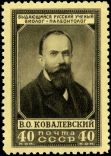 |
"Greatest Russian scientist biologist-paleontologist: V. O. Kovalevsky", USSR 1952 MiNr.: 1621, Scott: 1616. This is the first stamp dedicated to paleontologist. |
-
Alexander Onufrievich Kovalevsky (1840 -1901), shown on the blue
stamps, was a Russian embryologist of Polish descent who is best known for his studies of animals.
His research showed that all animals go through a period of gastrulation (the process by which the young embryo acquires its three germ layers).
Kovalevsky was the Russian founder of comparative embryology and experimental histology. His demonstration of a common development pattern in the embryological development of multicellular animals, both vertebrates and invertebrates, provided important evidence of the evolution of living organisms. [R7] -
Sofia Vasilyevna Kovalevskaya (1850–1891), depicted on violet stamp, was a
Russian mathematician who made noteworthy contributions to analysis, partial differential equations and mechanics.
She was the first major Russian female mathematician and a pioneer for women in mathematics around the world.
She was the first woman appointed to a full professorship in Northern Europe and was also one of the first women to work for a scientific journal as an editor.
Her sister was the socialist and feminist Anne Jaclard.
Despite her obvious talent for mathematics, she could not complete her education in Russia. At that time, women there were not allowed to attend universities.
In order to study abroad, she needed written permission from her father (or husband). Accordingly, she contracted a "fictitious marriage" with Vladimir Kovalevsky, then a young paleontology student who would later become famous for his collaboration with Charles Darwin. [R8]
[3] Vladimir Onufreivich Kovalevsky (1784-1856) was a Russian paleontologist.
Kovalevsky was one of the first adopters of Charles Darwin’s theory of evolution in Russia, he is most notable for his early work on the evolution of cloven-hoofed animals, especially the Hippomorpha family.
Vladimir Onufrievich Kovalevsky became the first Russian naturalist whose report was read at a meeting of members of the Royal Society in London, at that time the most authoritative scientific institution not only in Great Britain, but in the world.
The topic of the report was the study of the evolution of ungulates. The work of the Russian scientist was presented to the Royal Society by the famous scientist Thomas Huxley, who was often called as "Darwin's Bulldog" for his advocacy of Charles Darwin's theory of evolution.
Huxley presented the work of Kovalevsky as "the most important work in the last twenty-five years" and "sets the stage for a whole line of research."
[R9]
[4] Karl Rouillier (1814-1858) was the son of a French shoe maker who had immigrated to Russia. Rouillier was a zoologist, geologist, paleontologist and professor, who introduced ideas and approaches to understanding evolution in Russia, questioning the paradigm of the time of species being fixed and unchanging from the time of Biblical Creation.
Rouillier introduced the comparative historical method of investigation of the organic world. His work on studying the instincts of animals and their mental activity laid the foundations of evolutionary trends in animal psychology. [R10]
[5] "XII International Botanical Congress" took place between 3 and 10 July in Leningrad (now St. Peterburg).
The logo of the congress surrounded with 5 different plants: four modern and one fossil: Livistona palibinii at top.
The same fossil is depicted on the illustration and imprinted stamps on two postal stationaries (cover and postcard) shown below.
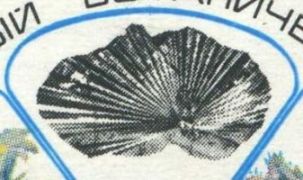 |
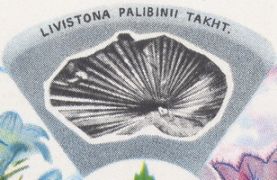 |
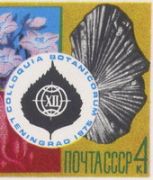 |
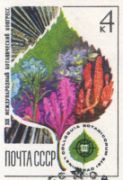 |
| From left to right: fossil Livistonia palibinii on postage stamp, cachet and imprinted stamp from the postal stationeries, both postcard and envelope. | |||
[6] The stamp of Charles Darwin exists in two perforation variation: 12.5x12.0 - MiNr: 2195A, Scott: 2166 and 12.50x12.50 - MiNr: 2195C, Scott: N/A. The second variation, not listed in Scott, is rare and expensive.
Other stamps to consider: contributors to Paleontology science, congresses of historical science
| 08.01.1958 "250th anniversary of Carl Linne" [O1] | 10.10.1963 "Russian scientists: 100th anniversary of Vladimir Obruchev" [O2] | 16.08.1970 "XIII International Congress of historical science" [O3] |
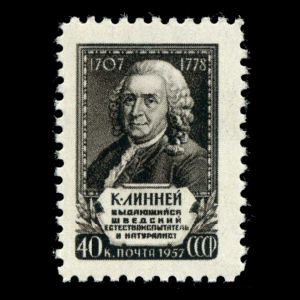 |
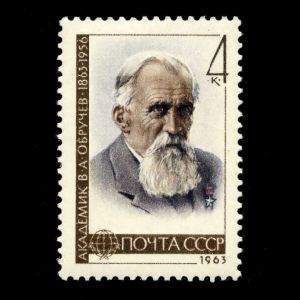 |
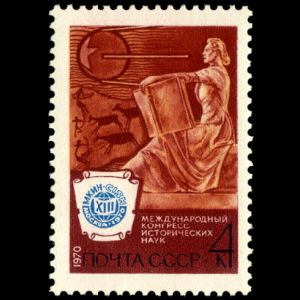 |
| 09.08.1973 "1000th anniversary of Al-Bîruni (973-1048)" [O5] | 16.08.1980 "1000th anniversary of Avicenna / Ibn Sina (980-1037)" [O6] | 12.12.1991 "Russian historians" [O4] |
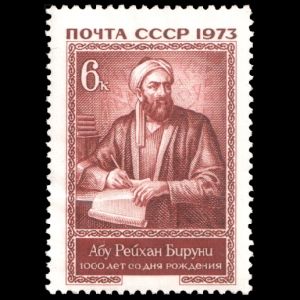 |
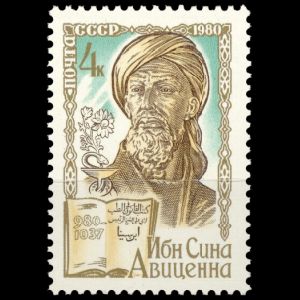 |
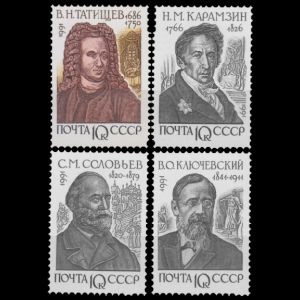 |
Notes:
[O1] Carl Linne (1707 - 1778) Sweden Carl Linnaeus, was a botanist, physician, and zoologist, who laid the foundations for the modern scheme of binomial nomenclature uses in all biology related since, include paleontology. He is known as the father of modern taxonomy and is also considered one of the fathers of modern ecology. [R11]
[O2] Vladimir Afanasyevich Obruchev (1863- 1956) was a Russian and Soviet geologist who specialized in the study of Siberia and Central Asia, as well as one of the first Russian science fiction authors, who found a big fossil site in Gobi desert of Mongolia.
He was the first paleontologist to discover fossil bones of Tertiary mammals (a rhinoceros tooth), in a hollow at Kuldzhin Gobi of Inner Mongolia in 1892.
This find radically altered the previous understanding of the Gobi Desert as an area covered by marine Tertiary sediments.
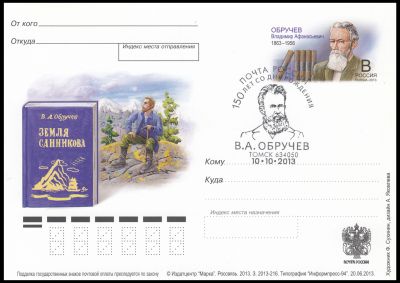
|
| V. A. Obruchev on postal stationery and postmark of Russia 2013. |
(Borisyak is founder and first director of the Paleontological Institute of the USSR Academy of Sciences. Since 2008, the Institute bears his name.)
From 1922 to 1925, the American Museum of Natural History expedition discovered a number of localities with fossil reptiles and mammals from terrestrial deposits.
This allowed them to subdivide the sedimentary record of Inner Mongolia into 12 successive horizons of Cretaceous and Tertiary age.
The most significant finding was the discovery of Cretaceous Mammals and Dinosaur eggs and nests. The American expedition was a light, mobile group, that was well-equipped technologically and had a number of talented scientists on the mission.
This allowed them to cover a large amount of ground – searching and collecting materials from all over Inner Mongolia.
"No matter how significant the opening of the Americans - wrote A. A. Borisyak - yet the first major discoveries in Asia, though much farther west, were made by Russian hunters". [R12]
Vladimir Afanasyevich Obruchev appeared on some postal stationeries and postmarks of Russia too.
[O3] Prehistoric animals on cave painting shown on the background of "XIII international congress of historical sciences" stamp.
[O4] Vasily Nikitich Tatishchev (1686-1750) was a prominent Russian statesman and polymath, the author of the first full-scale Russian history and the founder of three Russian cities in the Urals: Ekaterinburg, Perm and Togliatti.
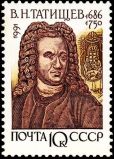
|
| V. N. Tatishchev, USSR 1991, MiNr.: 6253, Scott: 6052. |
The Kunstkamera is the first Museum of Russia and was founded by Peter the Great in 1727 and it is shown on several Soviet and Russian stamps and postal stationeries.
Tatishchev himself undertook expeditions to the Urals and to Siberia, where he acquired many bones of mammoths ("mamontova kost"), that became the legendary species in the Europe at that time: some naturalists believed in its mineral origin.
Tatishchev became the first Russian researcher of fossil animals who correctly described and identified it as the bones of an elephant by comparing morphology and chemical composition.
Tatishchev is the author of the first scientific paper about fossil ivory and mammoth «Mamontova kost, i.e. ossa subterranea, fossilia, ingentia, ignot animalis Siberia adefferri coepta» (published in Stockholm, 1725).
In this paper, he stated that the Mammoth was a native species of Siberia, rejecting ideas for the remains of mammoths: as alluvia from Asia during the Great Flood, or as elephants lost during conquest of India by Alexander the Great etc.
This was a quite innovative explanation for his time, as complete skeletons of mammoths and pieces of their wool had not yet been found. [R13]
In 1985, Tatishchev was depicted on a cachet of a postal stationery.
[O5] Abu Rayhan Muhammad ibn Ahmad al-Biruni (973-1048) commonly known as al-Biruni, was a scholar and polymath during the Islamic Golden Age.
al-Biruni was born in the outer district (Bīrūn) of Kath, the capital of the Afrighid dynasty of Khwarezm (Chorasmia) in Central Asia - now part of the autonomous republic of Karakalpakstan in the northwest of Uzbekistan.
At the time of the stamp issue, Uzbekistan was part of Soviet Union.
He has been called variously the "founder of Indology", "Father of Comparative Religion", "Father of Modern Geodesy". Al-Biruni is considered by some to be the first anthropologist as he studied the customs and religions of India.He expressed an opinion about the possibility of the Earth moving around the Sun and determined the circumference of the Earth.
He may have been the first person to suggest a standard ordering of geologic time with different eras that followed one another. In this way, he identified the concept of stratigraphy.
In his work about India, he suggested, based on fossil evidence, that the region had been under sea. It was quite innovative thinking.
In Europe, scholars and later scientists believed in an unchanging Earth until 19th century.
[R20]
[O6] Ibn Sina, known in the West as Avicenna (980-1037), was a Persian polymath who is regarded as one of the most significant physicians, astronomers, thinkers and writers of the Islamic Golden Age and the father of early modern medicine.
Ibn Sina was born in present-day Uzbekistan, which at that time was ruled over by a Persian dynasty (the Samanids).
In 1027 Ibn Sina stated in his "Book of Healing", that fossils are formed when remains of dead animals and plants are turned to stone by a petrifying virtue which seeps from the earth, perhaps during earthquakes or other slower upheavals.
“If what is said concerning the petrifaction of animals and plants is true, the cause of this (phenomenon)
is a powerful mineralizing and petrifying virtue which arises in certain stony spots, or emanates suddenly
from the earth during earthquakes and subsidences, and petrifies whatever comes into contact with it.
As a matter of fact, the petrifaction of the bodies of plants and animals is not more extraordinary than
the transformation of waters.”
Post stationary directly related to Paleontology: fossils, reconstructions of prehistoric animals, paleontologists
| 10.03.1975 VIII "International Congress on Stratigraphy and Geology Carbon" | 11.05.1975 "XII International Botanical Congress" (cover and post card) [5] | |
 |
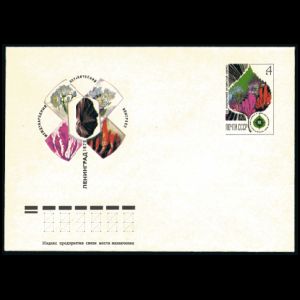 |
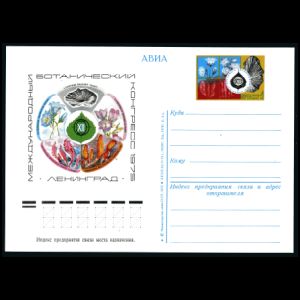 |
| 1976 "Permafrost research station in Yakutia" [PS1] | 1982 "Russian paleontologist and author I. A. Efremov" [PS2] | 19.11.1986 "Soviet geologist and paleontologist A.A. Chernov" |
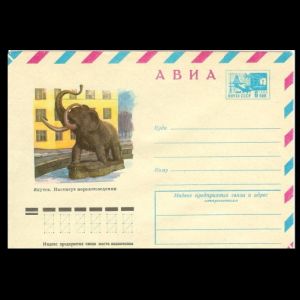 |
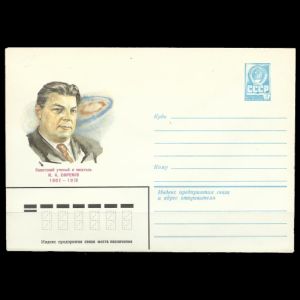 |
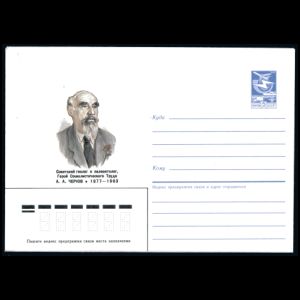 |
| 29.12.1986 "Permafrost research institute, Yakutia" [PS1] | 13.02.1989 "Soviet geologist and paleontologist D.V. Nalivkin" | |
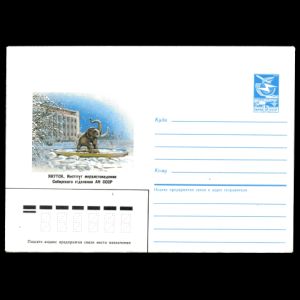 |
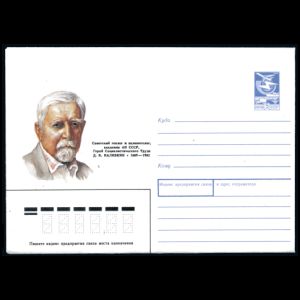 |
|
Notes:
[PS1] The sculpture of mammoth in front of the Permafrost Research Institute in Yakutsk, shown on the cachet of some Soviet postal stationeries (illustrated, prestamped envelopes).
The Mammoth monument, designed by Soviet artist Lev Georgievich Adonin, installed in 1972 in the middle of a fountain in the front of Permafrost Research Institute in Yakutsk, Russia.
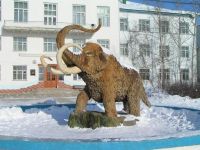
|
| Mammoth sculpture on front of Permafrost Research Institute in Yakutsk |
The artist worked together with the Institute staff to create as realistic as possible model.
Nowadays it is one of the most popular sightseeing locations in Yakutsk.
The Permafrost Institute, was founded in 1960, is a member institution of the Siberian Branch of Russian Academy of Sciences, and is dedicated to basic and applied investigations in two broad areas:
- permafrost evolution in relation to natural and anthropogenic factors
- thermal and mechanical interactions between engineering structures and permafrost
[PS2] Ivan Antonovich Efremov (1907-1972) was a Soviet paleontologist, science fiction author and social thinker.
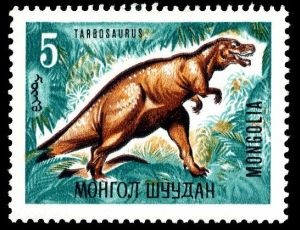
|
| Tabrosaurus efremovi named after I. A. Efremov on stamp of Mongolia 1967, MiNr.: 460, Scott: 447. |
In 1924, due to the influence of academician Sushkin, he became interested in paleontology.
In mid-1930s, he took part in several paleontological expeditions to the Volga region, the Urals and Central Asia.
He headed a research laboratory at the Institute of Paleontology.
During an expedition to the Gobi Desert in Mongolia, Efremov discoverd many fossils of various dinosaur species.
One of the species of the genus Tarbosaurus is named after him – Tarbosaurus efremovi, which is depicted on a stamp of Mongoloia in 1967. [R15]
In 1990s, Tarbosaurus efremovi was renamed to Tarbosaurus bataar.
Tarbosaurus is a genus of tyrannosaurid dinosaur that lived in Asia about 70 million years ago,
at the end of the Late Cretaceous Period, considered to contain a single known species, Tarbosaurus bataar.
Fossils have been discovered in Mongolia, with more fragmentary remains found further afield in parts of China.
[R18]
In 2014, Mongolia issued stamps set dedicated to Tarbosaurus bataar.
Some other postal stationaries to consider: Natural History Museums, prehistoric animals as art objects, contributors to Paleontology science
| 1959 "Avicenna / Ibn Sina (980-1037)" [O6] | 18.04.1973 "Amber museum of Palanga" [PSO1] | 1975 "100th anniversary of Lev Semyonovich Berg" [PSO4] |
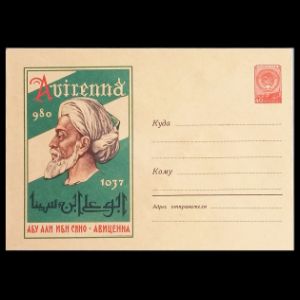 |
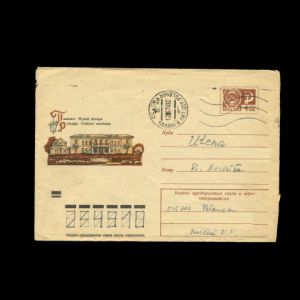 |
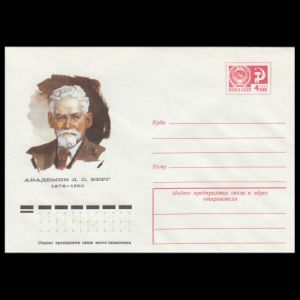 |
| 02.03.1982 "Yakutsk. Permafrost Institute" [PS2] | 25.12.1985 "Vasily Tatishchev" [O4] | 04.01.1987 "Amber museum of Palanga" [PSO1] |
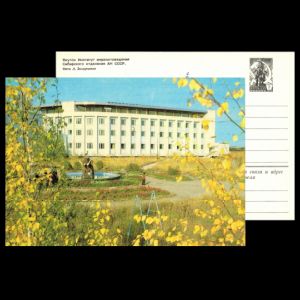 |
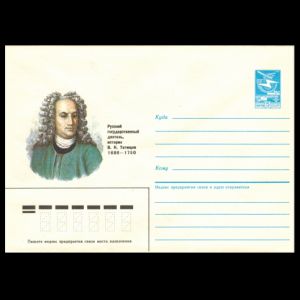 |
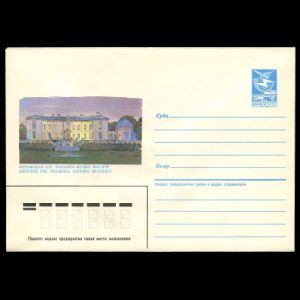 |
| 1987 "Amber museum of Kaliningrad" [PSO1] | 1990 "The monument to the mammoth in Kuleshovka" [PSO2] | 13.05.1991 "The monument of fighting Brontosaurus with Ceratosaurus" [PSO3] |
 |
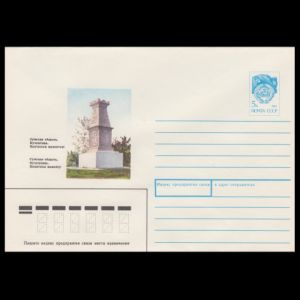 |
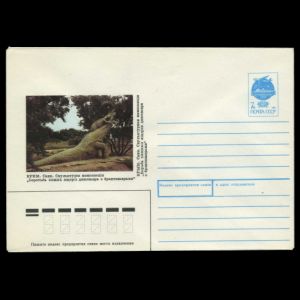 |
Notes:
[PSO1] Amber museums of Palanga (nowadays Lithuania) and of Kaliningrad (nowadays Russia) shown on the cachet of several postal stationeries of the Soviet Union, as well as on some stamps of Lithuania and Russia, issued after dissolution of the Soviet Union.
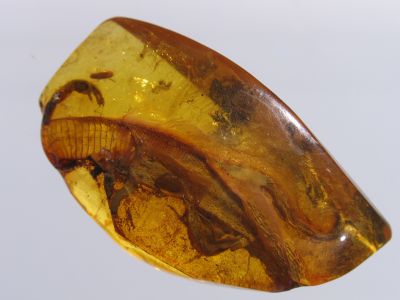 |
| Prehistoric lizard in Amber from collection of Kaliningrad Regional Amber Museum. Image credit: Wikipedia |
Amber is fossilized tree resin, which has been appreciated for its color and
natural beauty since Neolithic times.
The Baltic region is home to the largest known deposit of amber, called Baltic amber or succinite.
It dates from 44 million years ago (during the Eocene Epoch).
It has been estimated that these forests created more than 100,000 tons of amber.
Today, more than 90% of the world's amber comes from the Baltic region.
In 2009, Lithuania issued a set of stamps that shows several Ambers from the collection of the Museum in Palanga: "From the stocks of museums. Palanga Amber Museum". The exposition of the museum shows the history of amber formation, its global distribution, and ways of trade, processing and practical application.
Prehistoric insects encased in Amber are shown on one of the labels printed between stamps in the sheet. [R16]
[PSO2] The monument to the mammoth in Kuleshovka (Ukraine) shown on the cachet of the Soviet postal stationery. The monument is the first such monument in the world.
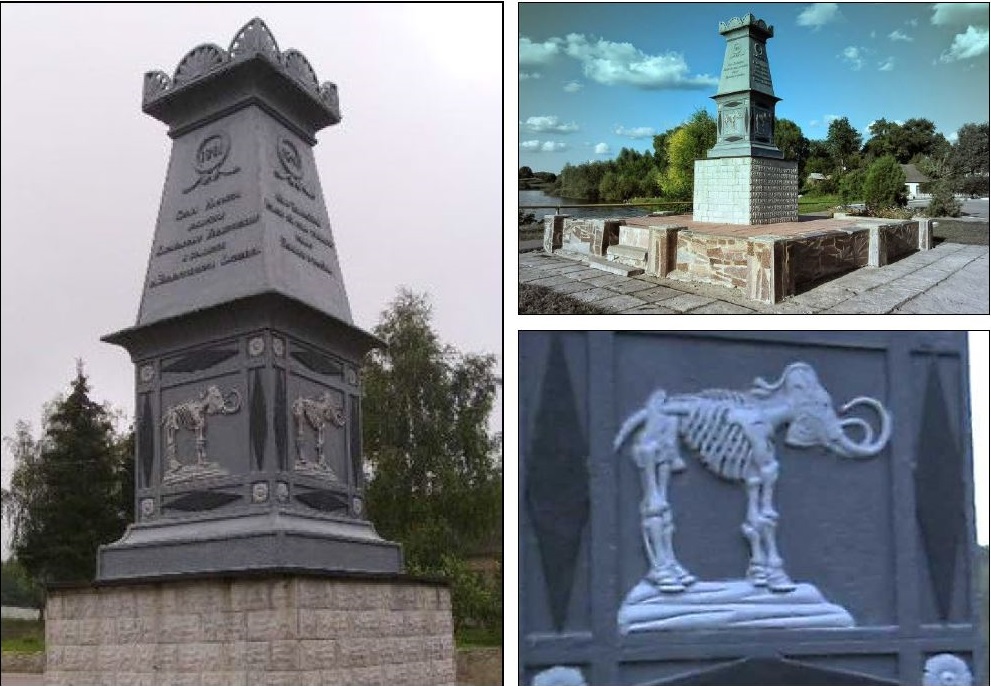
|
| Skeletion of Mammuthus trogontherii on monument in Kuleshovka, Ukraine. |
Kalinichenko dug out a well-preserved skeleton of Mammuthus trogontherii (steppe mammoth), discovered during construction of a distillery.
Besides the skeletons of mammoths many bones of other prehistoric mammals of the Ice Age such as woolly rhinoceros, giant deer, wild horses have been found there as well.
All unearthed fossils were donated to the zoological cabinet of Kharkov University.
Follow the suggestion of Professor Kalinichenko and with the participation of the landowner Yurij Golovkin, the 3-meter cast-iron memorial was installed at the site where the bones were unearthed. [R17]
[PSO3] The cachet of this prestamped envelope show the statue "Fighting Brontosaurus with Ceratosaurus" in Saki town on the Crimea peninsula, that time Soviet Union, now Ukraine.
The sculpture was installed in 1932 and was the first sculpture of dinosaurs on the mainland of Europe and the only second in the world, after some sculptures created by Benjamin Hawkins for the Crystal Palace in London, in 1854.
More details are here.
[PSO4] Lev Semyonovich Berg (March 14, 1876, Bender (Moldova today) – December 24, 1950) was a leading Soviet geographer, biologist and ichthyologist who served as President of the Soviet Geographical Society between 1940 and 1950.
He also developed his own evolutionary theory (Nomogenesis) as opposed to the theories of Darwin and Lamarck.
Studied both modern and prehistoric fishes, one of his most famous publication is "Classification of fishes, both recent and fossil" published in 1940, Between 1934-1950 - Director of the Laboratory of fossil fish of the Zoological Institute of the USSR in Leningrad.
In 2016, Post of Moldova issued a postal stationery to commemorate 140 th anniversary of Lev Semyonovich Berg [R19]
Commemorative postmarks related to Paleontology: fossils, prehistoric animals
Legend is here| 13.09.1975 VIII "International Congress on Stratigraphy and Geology Carbon" [Sp] | 15.08.1990 "Prehistoric animals" [FDC] | |
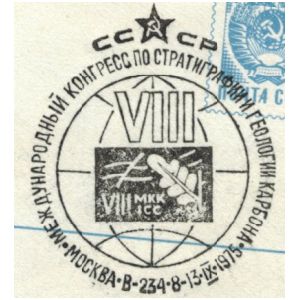 |
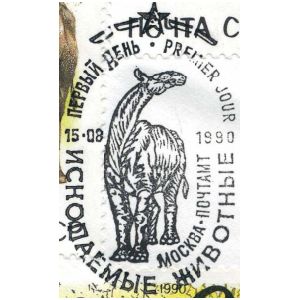 |
|
References:
- [R1] Soviet Union: Wikipedia,
- [R2] Postal History and Philately of Soviet Union: Wikipedia.
- [R3] Helicoprion: Wikipedia.
- [R4] Aleksandr Karpinsky: Wikipedia, Strange Science.
- [R5] Aleksei Nikolaevich Severtsov: Encyclopedia.com. Encyclopedia2 the free Dictionary, Wikipedia (in Russian).
- [R6] Kliment Arkadievich Timiryazev: Wikipedia.
- [R7] Alexander Onufrievich Kovalevsky: Wikipedia, BMJ Journals.
- [R8] Sofia Vasilyevna Kovalevskaya: Wikipedia.
- [R9] Vladimir Onufreivich Kovalevsky: Wikipedia, Nauka i Technika (in Russian).
- [R10] Karl Rouillier: Wikipedia, encyclopedia.com.
- [R11] Carl Linne: Wikipedia.
- [R12] Vladimir Afanasyevich Obruchev: Wikipedia.
- [R13] Vasily Nikitich Tatishchev: Wikipedia, Encyclopedia Britannica.
- [R14] The Permafrost Research Institute in Yakutsk: official website, Wikipedia.
- [R15] Ivan Antonovich Efremov: Wikipedia.
- [R16] Amber and Amber Museums: Amber (Wikipedia), Kaliningrad Regional Amber Museum (Wikipedia), Palanga Amber Museum (Wikipedia).
- [R17] The monument to the mammoth in Kuleshovka: ua.igotoworld.com, ukrinform.ru, Wikipedia (in Ukranian).
- [R18] Tarbosaurus: Wikipedia.
- [R19] Lev Semyonovich Berg: Wikipedia,
- [R20] Abu Rayhan Muhammad ibn Ahmad al-Biruni: Wikipedia, fossilbiasblog.com, islam.fandom.com.
- [R21] Ibn Sina, also known as Avicenna:
"Paleontology: An illustarted History", by David Bainbridge. Published in 2022,
Wikipedia, Encyclopedia Britannica, Strange Science, Fossil Bias Blog, Muslim Heritage.
Acknowledgements:
Many thanks to
- Dr. Peter Voice from Department of Geological and Environmental Sciences, Western Michigan University, for the draft page review and his very valuable comments.
- fellow collector Andrey Enyashin from Ekaterinsburg, Russia for his comments and help finding information about philatelic items from the USSR.
- fellow collectors Mr. Andrey Enyashin and Mr. Alexander Pedchenko from Russia for their comments and help finding some missing postal stationeries and postmarks.
| << previous country | back to index | next country >> |